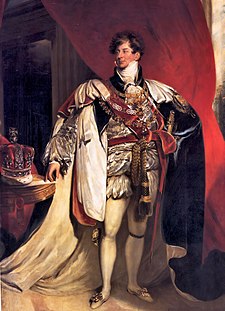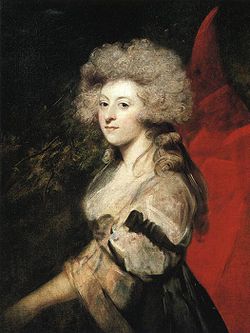
One of my mother’s favorite expressions is “Spoiled by a damned eyewitness!” which she gleefully utters when a person explodes an apocryphal anecdote about someone or something by contradicting a widely accepted version of events, then remarking that they were present at the time. The eyewitness naturally goes on to insert his or two cents on what really happened.
My research for my current historical nonfiction manuscript on notorious royal marriages has yielded several of these “spoiled by a damned eyewitness” moments, and I live for them! Some of the scandalous love affairs (which eventually became marriages, or the subject of judicial review) that I profiled in ROYAL AFFAIRS, my maiden voyage into nonfiction, will be revisited in my book on notorious royal marriages. It seemed egregious to omit them, merely because I’d mined some of the same territory in an earlier book (never expecting that I’d eventually get a contract to write a companion volume).
As an example, George IV’s two exceptionally notorious marriages could not be ignored just because I’d taken a different slant on them in a previous book. And in my decision to include a handful of rewritten entries bolstered by new and additional research, I figured I was in relatively good company; during the past couple of years I’ve read quite a few historical biographies that are updated and revised editions of an author’s prior tome on the same subject.
Having a much longer deadline for this wip (which still feels too short!) than I had for ROYAL AFFAIRS (a whirlwind of less than six months to research and write the ms.) has enabled me to discover additional sources. No wonder historical biographers love to revisit their old friends when they discover something new about them—material that contradicts the long-held theories about who a given person really was. I have no interest in agendist or apologist biographies (which too often inappropriately impose 20th and 21st century constructs and mores on a subject). However, I love finding primary source material that had not been included in other biographies, and which shines a different colored gel on that subject. . . .
My research for my current historical nonfiction manuscript on notorious royal marriages has yielded several of these “spoiled by a damned eyewitness” moments, and I live for them! Some of the scandalous love affairs (which eventually became marriages, or the subject of judicial review) that I profiled in ROYAL AFFAIRS, my maiden voyage into nonfiction, will be revisited in my book on notorious royal marriages. It seemed egregious to omit them, merely because I’d mined some of the same territory in an earlier book (never expecting that I’d eventually get a contract to write a companion volume).
As an example, George IV’s two exceptionally notorious marriages could not be ignored just because I’d taken a different slant on them in a previous book. And in my decision to include a handful of rewritten entries bolstered by new and additional research, I figured I was in relatively good company; during the past couple of years I’ve read quite a few historical biographies that are updated and revised editions of an author’s prior tome on the same subject.
Having a much longer deadline for this wip (which still feels too short!) than I had for ROYAL AFFAIRS (a whirlwind of less than six months to research and write the ms.) has enabled me to discover additional sources. No wonder historical biographers love to revisit their old friends when they discover something new about them—material that contradicts the long-held theories about who a given person really was. I have no interest in agendist or apologist biographies (which too often inappropriately impose 20th and 21st century constructs and mores on a subject). However, I love finding primary source material that had not been included in other biographies, and which shines a different colored gel on that subject. . . .

Which brings us back to saints and sinners. Since I can’t get them out of my mind, I’m eager to share a few of my recent discoveries about the two wives of the man who would become George IV, the big—and I do mean big—guy at the top of that sainted period known as the Regency, that kinder, gentler era (hah!) that was filled to the rafters with sinners of all stripes (and at the top of he heap was the bigamous Prinny).
The “Saint”
History tells us that the twice-widowed Maria Fitzherbert was a devout Catholic, patient as Griselda, maternal as Mother Teresa, and as long-suffering as Niobe. And certainly, George was awful to her, as were several of his cronies in Parliament, particularly Charles James Fox who vociferously denied the reality of her December 15, 1785 marriage to the Prince of Wales in a thundering oration delivered in the House of Commons. He lied because the prince had literally crossed his heart and vehemently denied that a wedding ceremony took place. Of course, to have done so would have cost him the crown. His clandestine wedding to Maria, while “legal” in the eyes of the Catholic Church, violated about five statutory laws, and in the case of the heir to the throne, civil law took precedence over canon law.

Mrs. Fitzherbert is often depicted as the long-suffering romantic victim of the Prince of Wales. But my second visit with her life exploded some of the myths about her personality. Evidently, she had a “fierce temper” in the words of the prince, but his estimation is corroborated by others who knew her well. She was also a woman of spirit and spunk who liked an off-color joke, spoke frankly, and (although her income had derived from her marriage settlements) was remarkably self-reliant. Like her royal admirer, she was vain, proud, and not without a sizeable ego. One of these “damned eyewitnesses” to the real Maria was her dear friend Lady Anne Lindsay, with whom she decamped to the Continent after Maria capitulated to George’s bedside marriage pledge (which followed his melodramatic, botched suicide attempt).
In Lady Anne’s words, “In spite of much nonsense, some haughtiness, some duplicity, I like her. She is . . . lovely and lovable amidst her circle of foibles and follies . . . whose inconsistencies deserve a long chapter from some historian who will attempt to draw her character and will make no real likeness because she has no fixed character but a medley of inconsistent and inconsequent particulars.”
The “Sinner”
Nothing can excuse Caroline of Brunswick’s emphatic inattention to personal hygiene, but did she really deserve to be called “the fiend” by her husband? A victim of her society’s double standards, Caroline was blatantly bawdy in an era when ribald humor was de rigueur—as long as it was men who were telling the jokes. And she was highly sexed in an age when marital infidelity seemed rather the rule than the exception—as long as the dalliances were discreet. Caroline blew that one, too.

“I had rather see toads and vipers crawling over my victuals than sit at the same table with her,” her husband (the oversexed, hypocritical hypochondriac also known as the Prince of Wales) declared to Lord Malmesbury soon after their royal marriage. And during the course of said union, while the prince took numerous mistresses in addition to his brief flings (some of which resulted in royal bastards) Caroline’s sexual misconduct became the subject of two separate investigations—the 1806 “Delicate Investigation” and the 1820 “Bill of Pains and Penalties.”
The first time Caroline and I spent some time together, I confess that I was somewhat firmly in the camp that considered her vulgar in the extreme. But the Caroline I gave a second chance to during the past couple of weeks filled my heart with pity; consequently, my entry on her mutually unhappy marriage to the Prince of Wales has become one of my favorites within my forthcoming book.
She was deprived of companions who might have become friends and eventually deprived of her own daughter’s society. George considered Caroline a dreadful maternal role model, but he wasn’t about to win any medals for fatherhood either. Their daughter, Princess Charlotte, tended to blame her mother for their separation, though toward the end of her young life she observed, “My mother was bad, but she would not have become as bad as she was if my father had not been infinitely worse.”
Lonely and bored under the prince’s “Carlton House System,” which endeavored to keep her a shut-in and proscribed her companions—one of whom was her husband’s mistress, Lady Jersey—Caroline needed a confidant, but didn’t know who to trust. She sought allies, but the prince’s friends would not interfere in the royal marriage. She wished to see more of her child, to watch little Charlotte being bathed and fed. And when she learned that the head of the nursery, the kindly and efficient Mrs. Dashwood, was ill, Caroline availed herself of the disruption to break her husband’s rules, and begged to see her little girl at an unappointed time.
Her attendants and visitors could see her unhappiness. Lady Sheffield, who dined with the princess in Brighton in late July noted that “her lively spirits which she brought over with her are all gone, and they say the melancholy and anxiety in her countenance is quite affecting.”
Caroline was in marital purgatory, in her words “a princess and no princess, a married woman and no husband—never was dere a poor devil in such a plight as I.”
In the spring of 1814, when Tsar Alexander of Russia came to England, Caroline was omitted from the guest list for his reception at Carlton House. Charlotte added her mother’s name, but her father scratched it out again. Then he thrice prevented the Tsar from paying a social call on Caroline by sending messengers to intercept him.
One night at the opera house Caroline arrived to hear the orchestra playing “God Save the King.” The people remained on their feet and greeted her with resounding cheers. On her way home, her carriage was mobbed with sympathetic well wishers. Poking his head into her coach, one man assured the princess, “We will make the prince love you before we are done with him.”
George’s pettiness even went so far as to prohibit Caroline from worshipping at St. Paul’s; he reserved every seat in the cathedral for a service to commemorate the peace and she was turned away. Balls in her honor were cancelled when the prince forbade his friends from accepting invitations to attend them. And we know that he had the doors of St. Paul’s barred against her entry on his coronation day, prohibiting her from entering the cathedral, let alone being crowned beside him.
The opportunity to revisit these two women whose romantic lives I had profiled earlier, gave me additional angles from which to view them and altered my opinion of them as well. Mrs. Fitzherbert was not entirely a saint and Caroline of Brunswick, though many of her sins were of her own making, often comes across as more sinned against than sinning—which is one of the reasons the House of Lords (albeit reluctantly) refused to convict her after the hearings on the Bill of Pains and Penalties.

No comments:
Post a Comment